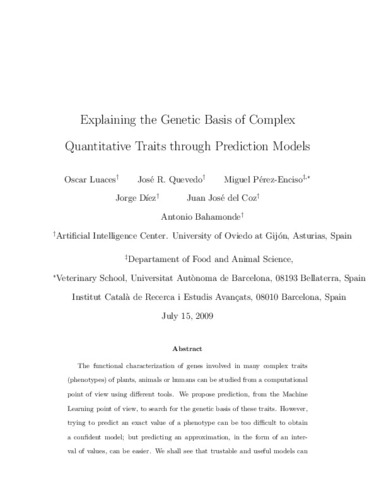Explaining the genetic basis of complex quantitative traits through prediction models
Publication date:
Editorial:
Mary Ann Liebert
Citación:
Descripción física:
Abstract:
The functional characterization of genes involved in many complex traits (phenotypes) of plants, animals or humans can be studied from a computational point of view using different tools. We propose prediction, from the Machine Learning point of view, to search for the genetic basis of these traits. However, trying to predict an exact value of a phenotype can be too difficult to obtain a confident model; but predicting an approximation, in the form of an interval of values, can be easier. We shall see that trustable and useful models can be obtained from this relaxed formulation. These predictors may be build as extensions of conventional classifiers or regressors. Although the prediction performance in both cases are similar, we show that from the classification field it is straightforward to obtain a principled and scalable method to select a reduced set of features in these genetic learning tasks. We conclude comparing the results so achieved in a real world data set of barley plants with those obtained with state-of-the-art methods used in the biological literature
The functional characterization of genes involved in many complex traits (phenotypes) of plants, animals or humans can be studied from a computational point of view using different tools. We propose prediction, from the Machine Learning point of view, to search for the genetic basis of these traits. However, trying to predict an exact value of a phenotype can be too difficult to obtain a confident model; but predicting an approximation, in the form of an interval of values, can be easier. We shall see that trustable and useful models can be obtained from this relaxed formulation. These predictors may be build as extensions of conventional classifiers or regressors. Although the prediction performance in both cases are similar, we show that from the classification field it is straightforward to obtain a principled and scalable method to select a reduced set of features in these genetic learning tasks. We conclude comparing the results so achieved in a real world data set of barley plants with those obtained with state-of-the-art methods used in the biological literature
ISSN:
Collections
- Artículos [37548]
- Informática [875]
Files in this item




